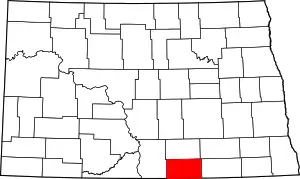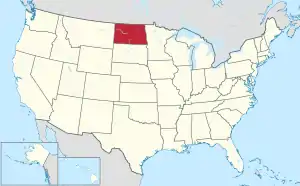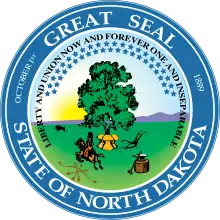McIntosh County, North Dakota
McIntosh County is a county in the U.S. state of North Dakota. As of the 2010 United States Census, the population was 2,809.[1] Its county seat is Ashley.[2]
McIntosh County | |
|---|---|
 McIntosh County Courthouse in Ashley | |
 Location within the U.S. state of North Dakota | |
 North Dakota's location within the U.S. | |
| Coordinates: 46°07′N 99°26′W | |
| Country | |
| State | |
| Founded | March 9, 1883 (created) October 4, 1884 (organized) |
| Named for | Edward H. McIntosh |
| Seat | Ashley |
| Largest city | Wishek |
| Area | |
| • Total | 995 sq mi (2,580 km2) |
| • Land | 975 sq mi (2,530 km2) |
| • Water | 20 sq mi (50 km2) 2.0% |
| Population (2010) | |
| • Total | 2,809 |
| • Estimate (2019) | 2,497 |
| • Density | 2.8/sq mi (1.1/km2) |
| Time zone | UTC−6 (Central) |
| • Summer (DST) | UTC−5 (CDT) |
| Congressional district | At-large |
History
The Dakota Territory legislature created the county on March 9, 1883, with areas partitioned from Campbelll, Logan, and McPherson counties, and with some previously-unorganized areas. It was named for Edward H. McIntosh, a territorial legislator at the time.[3] The county seat was originally Hoskins, but changed in 1888 after everything in Hoskins but the school was moved three miles east to the new Soo Line Railroad townsite of Ashley.[4] The county government was not organized at that date, but the new county was not attached to another county for judicial or administrative purposes. Its government was organized on October 4, 1884.[5]
Geography
McIntosh County lies on the south line of North Dakota. Its south boundary line abuts the north boundary line of the state of South Dakota. The terrain consists of rolling hills dotted with lakes and ponds, and with occasional protuberances.[6] The terrain slopes to the south, with its highest point on the north line at 2,156' (657m) ASL.[7] The county has a total area of 995 square miles (2,580 km2), of which 975 square miles (2,530 km2) is land and 20 square miles (52 km2) (2.0%) is water.[8]
Major highways
Adjacent counties
- Logan County - north
- LaMoure County - northeast
- Dickey County - east
- McPherson County, South Dakota - south
- Campbell County, South Dakota - southwest
- Emmons County - west
Protected areas[6]
- Camp Lake State Game Management Area
- Doyle Memorial State Recreation Area
- Green Lake State Game Management Area
- McIntosh County State Wildlife Management Area
- National Waterfowl Production Area
Lakes[6]
- Camp Lake
- Coldwater Lake
- Goose Lake
- Green Lake
- Kislingburg Lake
- Lake Hoskins
- May Lake
- Miller Lake
- Pudwill Lake
- Salt Lake
- Tschetter Lake
Demographics
| Historical population | |||
|---|---|---|---|
| Census | Pop. | %± | |
| 1890 | 3,248 | — | |
| 1900 | 4,818 | 48.3% | |
| 1910 | 7,251 | 50.5% | |
| 1920 | 9,010 | 24.3% | |
| 1930 | 9,621 | 6.8% | |
| 1940 | 8,984 | −6.6% | |
| 1950 | 7,590 | −15.5% | |
| 1960 | 6,702 | −11.7% | |
| 1970 | 5,545 | −17.3% | |
| 1980 | 4,800 | −13.4% | |
| 1990 | 4,021 | −16.2% | |
| 2000 | 3,390 | −15.7% | |
| 2010 | 2,809 | −17.1% | |
| 2019 (est.) | 2,497 | [9] | −11.1% |
| US Decennial Census[10] 1790-1960[11] 1900-1990[12] 1990-2000[13] 2010-2019[1] | |||
2000 census
| Languages (2000)[14] | Percent |
|---|---|
| Spoke English at home | 64.34% |
| Spoke German at home | 35.54% |
| Spoke Spanish at home | 0.12% |
As of the 2000 United States Census, there were 3,390 people, 1,467 households, and 975 families in the county. The population density was 3.48/sqmi (1.34/km2). There were 1,853 housing units at an average density of 1.90/sqmi (0.73/km2). The racial makeup of the county was 98.88% White, 0.15% Native American, 0.29% Asian, 0.03% Pacific Islander, 0.09% from other races, and 0.56% from two or more races. 0.83% of the population were Hispanic or Latino of any race. 82.2% were of German and 5.0% American ancestry.
There were 1,467 households, out of which 22.30% had children under the age of 18 living with them, 60.30% were married couples living together, 3.50% had a female householder with no husband present, and 33.50% were non-families. 32.00% of all households were made up of individuals, and 19.90% had someone living alone who was 65 years of age or older. The average household size was 2.19 and the average family size was 2.75.
The county population contained 19.40% under the age of 18, 4.60% from 18 to 24, 19.40% from 25 to 44, 22.40% from 45 to 64, and 34.20% who were 65 years of age or older. The median age was 51 years. For every 100 females there were 91.50 males. For every 100 females age 18 and over, there were 91.70 males.
The median income for a household in the county was $26,389, and the median income for a family was $31,771. Males had a median income of $22,153 versus $16,743 for females. The per capita income for the county was $15,018. About 10.60% of families and 15.40% of the population were below the poverty line, including 14.50% of those under age 18 and 18.90% of those age 65 or over.
2010 census
| Languages (2010)[14] | Percent |
|---|---|
| Spoke English at home | 74.22% |
| Spoke German at home | 24.70% |
| Spoke Spanish at home | 0.94% |
| Spoke a Scandinavian language at home | 0.11% |
| Spoke French at home | 0.04% |
As of the 2010 United States Census, there were 2,809 people, 1,307 households, and 800 families in the county.[15] The population density was 2.88/sqmi (1.11/km2). There were 1,858 housing units at an average density of 1.91/sqmi (0.74/km2).[16] The racial makeup of the county was 98.1% white, 0.4% Asian, 0.4% American Indian, 0.2% black or African American, 0.2% from other races, and 0.6% from two or more races. Those of Hispanic or Latino origin made up 1.4% of the population.[15] In terms of ancestry, 76.8% were German, 26.9% were Russian, 6.2% were Norwegian, and 5.2% were American.[17]
Of the 1,307 households, 19.4% had children under the age of 18 living with them, 55.0% were married couples living together, 3.5% had a female householder with no husband present, 38.8% were non-families, and 36.2% of all households were made up of individuals. The average household size was 2.07 and the average family size was 2.66. The median age was 52.7 years.[15]
The median income for a household in the county was $34,904 and the median income for a family was $46,198. Males had a median income of $35,200 versus $23,594 for females. The per capita income for the county was $22,608. About 9.2% of families and 13.9% of the population were below the poverty line, including 9.7% of those under age 18 and 20.2% of those age 65 or over.[18]
Communities
Township
Politics
McIntosh County is a powerfully Republican county. The only Democrats to carry McIntosh County have been Franklin D. Roosevelt in 1936 and 1932, plus Al Smith in 1928, both of whom owed their success to the county's overwhelmingly "wet" (anti-Prohibition) German-American culture. In 1920,[19] 1940,[20] 1944.[21] and 1952[22] elections the Republican Presidential candidate received over ninety percent of the county's vote. Although shifting somewhat Democratic in more recent Presidential elections, John McCain received nearly sixty percent of the county's vote in the 2008 U.S. presidential election.[23] President Donald Trump won seventy-seven percent of the vote in 2016, the best result in the county since Ronald Reagan.[24]
The county is represented in the US House of Representatives by Republican Kevin Cramer. As part of District 28 it is represented in the North Dakota Senate by Robert S. Erbele (R) and in the North Dakota House of Representatives by Mike Brandenburg (R) and Jeffery Magrum (R).[25]
| Year | Republican | Democratic | Third parties |
|---|---|---|---|
| 2016 | 76.1% 1,100 | 16.3% 235 | 7.7% 111 |
| 2012 | 67.7% 1,035 | 30.0% 459 | 2.4% 36 |
| 2008 | 59.8% 916 | 37.8% 579 | 2.4% 37 |
| 2004 | 72.8% 1,254 | 25.3% 436 | 1.9% 32 |
| 2000 | 72.0% 1,178 | 21.4% 350 | 6.7% 109 |
| 1996 | 56.4% 1,005 | 26.4% 470 | 17.2% 306 |
| 1992 | 55.2% 1,134 | 21.9% 450 | 22.9% 470 |
| 1988 | 73.5% 1,726 | 25.5% 598 | 1.0% 23 |
| 1984 | 81.5% 2,047 | 17.0% 427 | 1.6% 39 |
| 1980 | 86.0% 2,471 | 10.7% 308 | 3.3% 94 |
| 1976 | 64.3% 1,785 | 32.9% 912 | 2.9% 79 |
| 1972 | 81.6% 2,440 | 17.4% 521 | 1.0% 29 |
| 1968 | 82.7% 2,258 | 12.5% 342 | 4.8% 132 |
| 1964 | 66.6% 1,891 | 33.4% 950 | |
| 1960 | 81.1% 2,694 | 18.9% 628 | |
| 1956 | 84.2% 2,689 | 15.6% 498 | 0.2% 6 |
| 1952 | 90.9% 3,043 | 8.2% 276 | 0.9% 29 |
| 1948 | 79.4% 2,203 | 18.5% 513 | 2.2% 60 |
| 1944 | 92.0% 2,682 | 7.8% 226 | 0.3% 8 |
| 1940 | 91.7% 3,494 | 8.3% 318 | |
| 1936 | 40.5% 1,469 | 52.4% 1,900 | 7.2% 260 |
| 1932 | 13.1% 465 | 86.9% 3,078 | |
| 1928 | 44.8% 1,196 | 55.2% 1,474 | |
| 1924 | 34.5% 637 | 2.1% 39 | 63.4% 1,173 |
| 1920 | 94.3% 1,782 | 4.2% 79 | 1.5% 28 |
| 1916 | 77.4% 950 | 22.0% 270 | 0.7% 8 |
| 1912 | 21.0% 202 | 13.0% 125 | 66.0% 636 |
| 1908 | 86.5% 927 | 13.1% 140 | 0.5% 5 |
| 1904 | 92.5% 736 | 7.3% 58 | 0.3% 2 |
| 1900 | 84.0% 658 | 16.0% 125 |
References
- "State & County QuickFacts". United States Census Bureau. Archived from the original on June 7, 2011. Retrieved November 1, 2013.
- "Find a County". National Association of Counties. Archived from the original on May 31, 2011. Retrieved June 7, 2011.
- "County History". Official Portal for North Dakota State Government. Archived from the original on February 2, 2015. Retrieved May 4, 2011.
- Wick, Douglas A. "Hoskins (McIntosh County)". North Dakota Place Names. Retrieved May 4, 2011.
- "Dakota Territory, South Dakota, and North Dakota: Individual County Chronologies". Dakota Territory Atlas of Historical County Boundaries. The Newberry Library. 2006. Retrieved February 19, 2019.
- McIntosh County ND Google Maps (accessed 24 February 2019)
- ""Find an Altitude/McIntosh County ND" Google Maps (accessed 24 February 2019)". Archived from the original on May 21, 2019. Retrieved February 24, 2019.
- "2010 Census Gazetteer Files". US Census Bureau. August 22, 2012. Archived from the original on January 29, 2015. Retrieved February 1, 2015.
- "Population and Housing Unit Estimates". Retrieved April 3, 2020.
- "US Decennial Census". US Census Bureau. Retrieved February 1, 2015.
- "Historical Census Browser". University of Virginia Library. Retrieved February 1, 2015.
- Forstall, Richard L., ed. (April 20, 1995). "Population of Counties by Decennial Census: 1900 to 1990". US Census Bureau. Retrieved February 1, 2015.
- "Census 2000 PHC-T-4. Ranking Tables for Counties: 1990 and 2000" (PDF). US Census Bureau. April 2, 2001. Retrieved February 1, 2015.
- https://apps.mla.org/cgi-shl/docstudio/docs.pl?map_data_results
- "Profile of General Population and Housing Characteristics: 2010 Demographic Profile Data". US Census Bureau. Archived from the original on February 13, 2020. Retrieved March 14, 2016.
- "Population, Housing Units, Area, and Density: 2010 - County". US Census Bureau. Archived from the original on February 13, 2020. Retrieved March 14, 2016.
- "Selected Social Characteristics in the US – 2006-2010 American Community Survey 5-Year Estimates". US Census Bureau. Archived from the original on February 13, 2020. Retrieved March 14, 2016.
- "Selected Economic Characteristics – 2006-2010 American Community Survey 5-Year Estimates". US Census Bureau. Archived from the original on February 13, 2020. Retrieved March 14, 2016.
- David Leip’s Election Atlas statistics for 1920
- David Leip’s Election Atlas statistics for 1940
- David Leip’s Election Atlas statistics for 1944
- David Leip’s Election Atlas statistics for 1952
- The New York Times electoral map (Zoom in on North Dakota)
- "North Dakota Election Results 2016: President Live Map by County, Real-Time Voting Updates". Election Hub. Retrieved April 12, 2018.
- North Dakota Legislature site
- Leip, David. "Atlas of US Presidential Elections". uselectionatlas.org. Retrieved April 12, 2018.
External links
- McIntosh County map, North Dakota DOT
